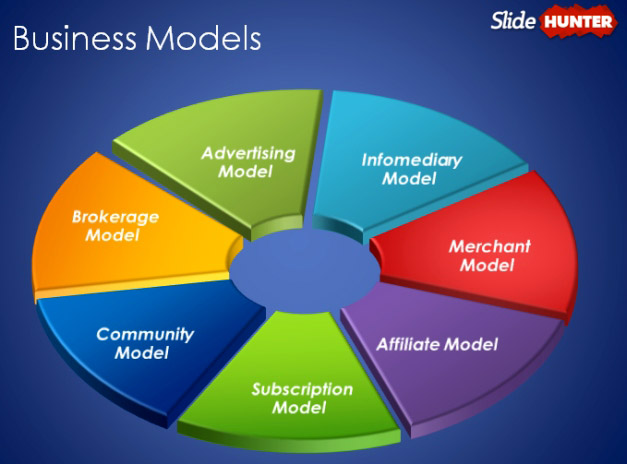Being the most discussed part of every business, Business Models are the least understood aspect of the web. Recently, these models have gone through vast changes but there needs to be more idea about what those alterations are and how they would benefit the future.
Actually, in basic terms, these models are the different methods of doing business that helps in establishing your company by generating significant revenues. So, for your E-commerce venture’s success, there must be some powerful business model.

No doubt, you can use plenty of ways to structure your business and each one has its own advantages and disadvantages but picking the right model will greatly influence your trade and will definitely take it to new heights.
Therefore, to enjoy the actual meaning of success, you must adopt any of the below discussed models. An overview to these different types of business models will not only guide you in having the strong foundation for your business but will also help you in reaping huge profits.
So when you are a new entrepreneur, you will often come across a question like what type of a business model you use. Having the knowledge of its various types before hand only will make you confident in front of your competitors and will portray you as a strong contender.
What are different types of business models?
Here is a brief discussion on some of these models which will surely benefit your business to a great extent.
Brokerage Model
In this model, a broker will offer some services to different parties and will charge them for that. These people are the market makers here and are responsible for bringing the buyers and sellers together for carrying out business transactions.
Advertising Model
It is actually the extension of the traditional media broadcast model in which the online company offers advertising services and products. Here, your website is the broadcaster which provides the content and services mixed with advertising messages in the form of banner ads.
Infomediary Model
Under this model, direct revenue is generated as the company receives money on the basis of its products and services which it offers to its business partners. Some firms might act as infomediaries in this case which will assist buyers and sellers in understanding the current market.
Merchant Model
Here in this case the company provides service and sells goods whereas the merchant is responsible for the products. So the overall sales which are made are all based on the list prices or through auction.
Affiliate Marketing Model
Companies following this model offers incentives to other affiliates who can help them in redirecting the customers towards them. Dealing under this model will provide you with unlimited purchase opportunities.
You may be curious about what is affiliate marketing. Affiliate marketing resembles sponsored partnerships where others help advertise your company for you. By setting up an affiliate marketing strategy, you’ll join forces with affiliates who will endorse your merchandise on their social media, blogs, and additional channels. These sales are tracked through unique URLs called affiliate links, enabling the promoter to be compensated for their contributions.
Community Model
This is the model which is based on user’s loyalty and the revenue generated in this case will depend upon the product type.
The Community Model is a business approach that relies on fostering user loyalty to generate revenue, with the amount of income depending on the nature of the product being offered. This model focuses on creating a sense of belonging and connection among users, who are drawn together by shared interests, goals, or values. By building a strong community around a product or service, businesses can tap into the power of social connections and word-of-mouth marketing to grow their customer base and revenue.
One of the critical aspects of the Community Model is cultivating an environment that encourages engagement, collaboration, and support among its members. This may involve creating forums, discussion groups, or social media platforms where users can interact, share ideas, and solve problems together. By offering valuable resources and opportunities for networking, businesses can strengthen their community’s commitment to the product or service, ultimately leading to higher user loyalty and retention.
In addition to fostering a sense of connection, the Community Model also emphasizes the importance of incorporating user feedback and input into the development and improvement of products or services. By actively seeking and incorporating user suggestions, businesses can demonstrate their commitment to meeting the needs and desires of their community members. This approach not only results in a more tailored and satisfying user experience but also reinforces the sense of ownership and loyalty among community members, who feel that their voices are heard and valued.
In summary, the Community Model is a business strategy that leverages user loyalty and the power of social connections to generate revenue based on the product type. By creating an engaging and supportive environment, actively seeking user feedback, and fostering a sense of belonging, businesses can strengthen their community and encourage long-term commitment to their products or services.
Subscription Model
In a subscription business model, it requires customers to pay a consistent fee at regular intervals (e.g., monthly, quarterly, annualy, etc.) in exchange for access to a specific product or service. The subscription model predates the digital era, originating in the publishing industry during the 17th century. Today, it continues to be used by newspapers and magazines, as well as in other industries like utilities and software provision. With the rise of SaaS, it is pretty common for companies to charge for a subscription fee and keep the user enrolled into a subscription.
The increasing prevalence of Software as a Service (SaaS) has led to a surge in subscription-based offerings for access to digital products. This business model has become a popular choice in various industries due to its convenience and ability to provide continuous updates and improvements to the software or digital product.
A crucial aspect of maintaining a successful subscription-based service is focusing on onboarding and customer retention. Onboarding involves creating a smooth and effective process for new users to familiarize themselves with the product or service, ensuring they understand its value and are encouraged to continue using it. This can include offering guided tours, video tutorials, or personalized support to help users get started and feel comfortable with the platform.
Customer retention is a vital part of any subscription-based strategy, as it aims to keep users engaged and satisfied over time. By focusing on delivering exceptional customer experiences, addressing concerns, and constantly improving the product, businesses can encourage users to remain enrolled in the service. Retaining customers not only reduces churn rates but also increases the Lifetime Value (LTV) of each subscriber, which ultimately contributes to the company’s profitability and growth.
Incorporating effective onboarding and customer retention practices into a subscription-based service is essential for ensuring users remain engaged and committed to the platform. This approach not only promotes customer satisfaction but also enhances the Lifetime Value of subscribers, fostering the long-term success of the business.
Under the subscription business model, clients are charged a recurring fee to obtain access to a product or service. Prominent examples of companies employing this model include Netflix and Spotify. But there are other examples like Adobe Creative Cloud, Office 365, Amazon Prime, New York Times, Dollar Shave Club, etc.
Final thoughts
In order to facilitate the customer communication and interaction, Subscription model is used. Here the users will be charged a periodic, daily or monthly fee for subscribing a particular service.
Hence, considering these models before initiating your business will not only bring a considerable improvement in your way of trading but will also take your e-commerce ventures on next level.

